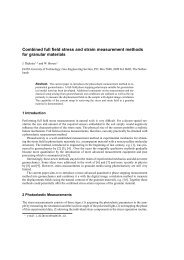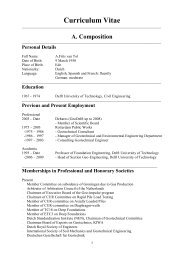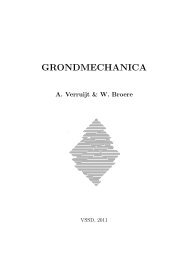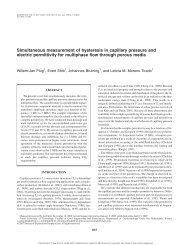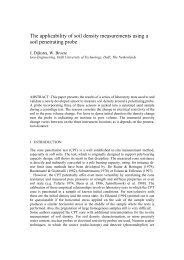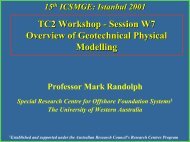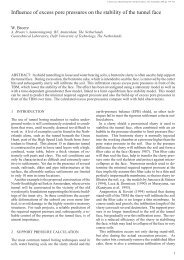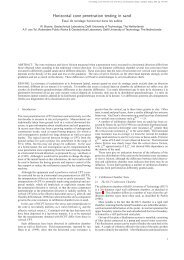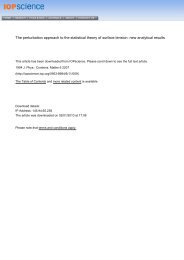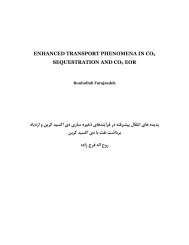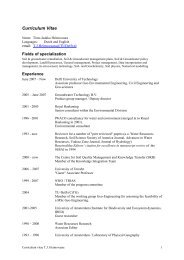Tunnel Face Stability & New CPT Applications - Geo-Engineering
Tunnel Face Stability & New CPT Applications - Geo-Engineering
Tunnel Face Stability & New CPT Applications - Geo-Engineering
Create successful ePaper yourself
Turn your PDF publications into a flip-book with our unique Google optimized e-Paper software.
8 2. <strong>Stability</strong> Analysis of the <strong>Tunnel</strong> <strong>Face</strong>This is only slightly higher than the best known upper bound solution, which has a factor 3.83instead of 4 [161]. It is assumed that a seepage flow is present and results in a horizontal dragforce γ w i [125]. In that case the maximum height of the cut can be estimated fromh c ≤ 4c uγ1f + √ f 2 + 1(2.7)with f = iγ w /γ or, inversely, the critical gradient can be determined.In cases where the groundwater flow towards the face becomes a problem, a closer analysis iswarranted. A possible approach would be to choose an arbitrary failure height for the slope, i.e. areference stress level, and then proceed with a slope stability analysis, e.g. Müller-Kirchenbauer’smethod, Bishop’s method or a fully numerical (FE) solution method [136]. Alternatively onecould use a semi-empirical approach as used in the analysis of piping phenomena, but with lessstringent safety factors, as the time span over which the slope has to remain stable is significantlyshorter [74, 115]. Since cases where the piezometric head within the excavation chamber is lowerthan outside are not very common and moreover fall outside the scope of this thesis,such analyseswill not be made here.2.1.2 Global <strong>Stability</strong> AnalysesA number of authors has described external failure mechanisms of the tunnel face and derivedformulae to calculate a suitable support pressure by analytical or empirical means. Historically,the first models were upper and lower bound plasticity solutions for an (associated) Trescamaterial. At later times solutions for non-associated Mohr-Coulomb material and limit equilibriummodels were published. The different models will be described briefly in the followingparagraphs and an overview is given in table 2.1. In part this table has been adapted fromBalthaus [23] and Krause [98].One of the first models was derived by Broms & Bennermark [48] in 1967. They derive arelationship describing the stability of unsupported vertical openings in an undrained cohesive(Tresca) material, see figure 2.3. With this relationship they define the stability ratio N to beequal to the difference between total overburden stress and support pressure divided by theundrained shear strength,N = q s − sc u+ γ c u(C + R), (2.8)with q s the surface load, C the overburden, R the tunnel radius and s the support pressure. Fromobservations of collapses in both building pits and tunnel constructions, and from laboratoryextrusion tests, they find that an opening in such conditions will become unstable for N > 6.In 1980 Davis et al. [63] investigate the stability of an idealised partially unlined tunnelheading in a Tresca material and introduce the distance P between the face and the point wherea stiff support is provided (Figure 2.4). They use the vertical opening as presented by Broms &Bennermark as one of three limit cases for their stability analysis. They further derive upper andlower bound plasticity solutions for the stability of a plane strain unlined cavity (Figure 2.4b) anda plain strain ‘long wall mining’ problem, obtained by taking P = ∞ in figure 2.4a. Their upperand lower bound solutions for the two-dimensional unlined cavity are summarised in figure 2.5.Of particular relevance to the face stability of a tunnel excavated using a shield machine is thecase P = 0. Davis et al. derive two lower bound solutions, using a cylindrical and a spherical



